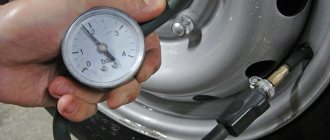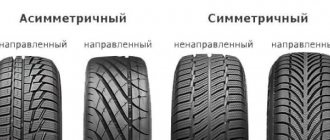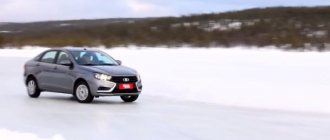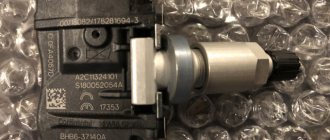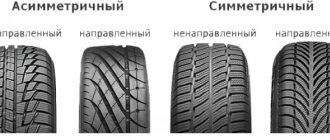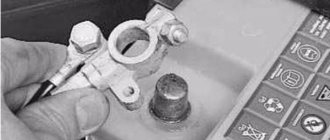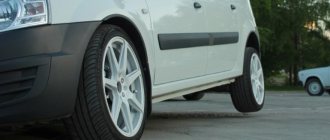05 December 2014 Lada.Online 122 824 8
An experienced driver knows how important it is to periodically check the pressure in your car's tires. If the pressure does not correspond to the recommended one, this leads to accelerated tire wear, as well as a deterioration in the stability and controllability of the vehicle. The table shows the recommended tire pressure for the Lada Granta.
What does air pressure in tires affect?
The pressure in car tires determines the level of driving comfort and safety, and also contributes to the durability of the working units and components of the car.
Low pressure in Lada Granta tires increases heating during rolling and contributes to wear of the tread tracks located along the edges. The integrity of the frame may even be compromised. Fuel consumption also increases. If you hit a pothole, the risk of damage to your rim or tire is much higher.
Tire pressure "Lada Grants"
Increased tire pressure on the Lada Granta overstrains the cord threads and wears out the middle section of the tread. In addition, when driving on a bad road, the shocks transmitted to the suspension and body will be more clearly felt by passengers. Of course, the suspension will also wear out more. And if you drive into a pit, the risk of a tire rupture increases.
Different pressure for all four wheels also has its drawback: in this situation, when braking, the car is guaranteed to be pulled to the side by the wheels with minimal pressure, and the car will actually start moving sideways.
Tire life
Reduced tire pressure on the Lada Granta increases tire abrasion at the edges.
Increased - also affects the service life of tires. In this case, the tension in the carcass threads increases: as a result, the cord breaks down noticeably faster. In this case, the tire interacts with the road through the middle section of the tread, which provokes its rapid wear.
Compliance with the recommended pressure allows you to evenly distribute the load and increase the tire life.
Machine controllability
The pressure of a specific value in the Lada Granta wheels is indicated for a reason. Although its reduced performance at low speeds does not particularly affect the car’s behavior, at speeds of 60 km/h or more, underinflated tires significantly worsen handling and increase braking distance.
A car with increased pressure in the tires on a dry road surface is somewhat better in handling, however, strong overinflation of the wheels leads to the fact that any sudden maneuver guarantees a skid (especially on a wet road), or even a complete loss of control.
With reduced pressure in the Granta wheels, the car’s ability to turn also changes. for example, a rear-wheel drive car with lowered front tires will have a harder time turning.
The inflation of the front wheels of a front-wheel drive car must always be normal, since its reduced level provokes skidding in an emergency situation.
P14 wheels on Grant
Patency
Even the owner of an ordinary four-wheel drive car, for example a sedan, can independently provide it with tolerable cross-country ability. To do this, just let some air out of the wheels, and they will not sag in sand, snow or mud. To even get out of a “black spot”, you just need to lower the pressure to 1.2 bar.
In a particularly difficult situation, if your wheels have a narrowed rim and a fairly wide tire (in this combination there is a lower risk of self-disassembly), the indicator can be increased to 1.0 bar.
Stability on slippery roads
A wet track always carries danger. But if you increase the pressure in the Lada Granta tires, reducing the contact patch of the rubber with the track, the risk of aquaplaning will also decrease. This will also improve handling and optimize fuel consumption. However, you need to know when to stop, as this option has its own disadvantage: an increased risk of a tire explosion.
If the car slips on wet grass, then, on the contrary, relieve the pressure.
Braking efficiency
The higher the pressure in the Grant R14 wheels, the less grip they have on the road. Consequently, the longer the braking distance: as the atmosphere decreases, it will decrease, but at the expense of reduced directional stability.
Selection of tires by model
Knowing the size of the “shoes”, all that remains is to choose the style. Any car should have two sets of tires: winter and summer. Winter tires are installed without waiting for frost, but when the thermometer regularly drops below +5 degrees.
To save on the purchase of winter tires, some drivers make the mistaken decision to drive all-season tires. Therefore, we will make a small digression and explain why this should not be done.
When and what tires are needed for a car?
Let’s say right away that there are no tires that behave stably in any conditions. Why then is the tire called all-season? Because of the tread, which must have a deep relief and grooves through which water, dirt, and slush can easily pass.
All-season tires are tires that are comfortable to drive in the off-season, when the air temperature varies from +7 to -10 degrees. It is often marked M+S (mud/snow), which confuses many.
But in fact, an all-season tire is a summer tire and is not suitable for year-round driving, even in the southern regions of the country.
- All mud tires, and all winter tires, have an all-season tread. The only difference is in the rubber composition, which is designed for positive or negative wheel operation. On a winter tire, for better grip on icy roads, many thread-like sipes are made, which distinguishes it from all-season tires.
- Studless winter tires are popularly called Velcro. On such tires, the car feels great in icy conditions, but when the temperature outside is consistently positive (above +6-7 degrees), it must be changed to summer shoes.
- Winter tires are much softer, so if you try to drive them in the summer, they will wear out quickly. Studded tires are better suited for driving on snow, so when in winter you have to drive not on cleared asphalt, but on a country road, it is better to give preference to studded tires.
- All year round, all-season vehicles are driven mainly by trucks and buses, on which changing wheels is a labor-intensive process, and besides, there are usually more than four of them. True, in severe frosts and snowfalls they have a hard time riding on such tires.
And another important factor is for those who spend a lot of time driving. A tire for winter use is much softer than a summer one, but it is also noisy when driving, especially the studded one.
The summer one, and it is also an all-season one, in severe frosts “steals” and just rattles. And this is not to mention the fact that you will not so much ride on the ice as perform figure skating.
What should be the pressure in Grant tires under different conditions?
For every 10 degree change in temperature, the air pressure in the tire also changes by 0.1 bar. So, if in summer the indicator should be 1.9-2.0 atmospheres, then in winter or at full load it reaches 2.1-2.2, and cars with summer tires in April, they can only be pumped up occasionally until the beginning of September. But the winter one will have to be checked regularly after the next frost.
In summer
In the summer, during extreme heat, the pressure in the p14 wheels on the Grant increases slightly due to the heating of the air in the tires. So you don’t have to pump them up, plus or minus 0.3 atm.
in winter
In winter, the air is compressed, which is why the tires need to be pumped to the same 0.3 atmospheres: even if in a warm garage the pressure gauge shows the desired value, on the street the value will drop by at least 0.3 bar, and you will find yourself with underinflated tires.
Installing a pressure gauge to check tire pressure
For a relaxing ride
In Lada Granta wheels, the pressure should be standard for quiet driving, that is, recommended. Car manufacturers place the “cheat sheet” on the gas tank cap, the middle pillar or on the driver’s side door. As a rule, you can use tires of different sizes, and the required value for them is not always the same.
For racing
In motorsports, everything is determined by the contact patch of the tire. By increasing or decreasing it, it is easy to change the handling of the sports car.
By reducing the pressure in the wheels of the Lada Granta liftback, we increase the contact area. If you increase the pressure, the car then responds better to the steering impulse, and straight line acceleration increases due to reduced rolling resistance.
But the traction properties of the tire will also become less: overinflated wheels seem to stand on tiptoes. So, depending on the requirements of your type of motorsport, you need to find a compromise so that the tires have enough grip during acceleration and braking, but do not deform when cornering due to low inflation.
For long trips
When traveling long distances, it is recommended to lower the tire pressure by 0.1 atmospheres. Long driving easily compensates for this decrease by heating the air, which expands as a result.
For driving in mud
When you find yourself on a muddy dirt road, it is better to lower the wheels: the contact area will increase, the ride will become more comfortable, and the suspension will not wear out.
For driving in open mud, it is better to reduce the pressure to 1 bar. Just remember that in this case you should not accelerate over 30 km/h. Otherwise you risk losing control. It is also undesirable to let the tires go down too much before descending a steep slope, since during braking the tires will rotate independently even after the wheel rims are locked.
For driving on snow and ice
If ice catches you by surprise, it is better to lower your wheels to 1.5 atm. Tire wear will, of course, increase, but cross-country ability will also increase significantly. However, in this case, any high speed is unlikely, and overheating of the rubber at low temperatures most likely will not occur.
Forcing deep snow also means reducing pressure: this way you will noticeably increase the contact area, and, on the contrary, minimize the pressure on the snow.
The main thing is not to overdo it. To avoid getting stuck in the snow, it is recommended to inflate tires to 0.8–1 atm. But if you have low-profile ones, it is better not to drop below 1.2 atm.
"Lada Granta"
Please note that even a short trip on lowered wheels heats up the air in them and increases the pressure.
For transportation of goods
It is advisable to take into account the manufacturer's advice on tire pressure when fully loaded. At a minimum, you should inflate the wheels at least at the rear by 0.2–0.3 bar.
Tire pressure Lada Granta liftback
Normally it should be at the level of 2.0 and 2.2 kg/cm2 for the front and rear axles, respectively. In this case, the optimal parameter is the same for all trim levels and does not depend on the size of the car wheels or the loading of the interior.
Users have established actual norms through experience. So, for unpaved areas or low-quality asphalt, motorists do not inflate tires by an average of 0.1-0.2 At. this is argued by improved comfort - soft rubber “swallows” small irregularities, ledges and potholes. The downside is reduced steering sensitivity and increased fuel consumption. If the machine is used on a high-quality road surface, it is allowed to overinflate the wheels by a similar amount. The result is a firm landing with improved dynamics.
How to determine tire pressure
Tires should be checked regularly: before a trip or once a week. Measure the pressure when the tires are cold, that is, several hours (4-5) after stopping the car. If pumping is required on the way, it is better to make it 10% more than normal. Verification can be carried out in different ways, which we will discuss further.
Compressor
A compressor is a special machine for inflating tires. Connect it to the mains and watch the built-in pressure gauge. When the pressure rises to the desired level, the device will simply turn off.
Pressure gauge
Using the pressure gauge is extremely simple:
- You need to remove the cap on a car tire.
- Apply the pressure gauge to the valve for a few seconds.
- Compare the performance of all four tires and, if necessary, inflate.
The entire procedure takes a maximum of a few minutes.
Sensors
The sensors convert the pressure information received from the wheel controllers into an electrical signal and transmit it to the transceiver via Bluetooth. A special program processes this data and, if necessary, signals the driver. Some systems send a message to a smartphone.
You can set the limit values of operating parameters yourself: adjustment is available from 1.7 to 3.2 bar.
Visually
It is better to carry out an inspection before each trip: at least just to see if there are any flat tires. But it is not possible to determine the pressure “by eye”: even 10 PSI and 20 PSI are practically indistinguishable in this way.
Handheld portable pressure gauge for checking tire pressure
Only a high-quality pressure gauge guarantees you an accurate result.
Is it possible to drive on flat tires?
Driving with flat tires is, of course, possible, but it is fraught with consequences.
This results:
- to wipe the side protectors;
- excessive heating of rubber and its accelerated deterioration;
- deterioration of vehicle controllability, especially when cornering;
- excessively high fuel consumption.
The only advantages of underinflated tires are a soft ride, and also the fact that there is no noise or rattling. However, the disadvantages of such use clearly outweigh the advantages.
Is it possible to drive on overinflated tires?
Of course, you can ride with such tires, but if you do it too often, you cannot avoid the consequences:
- the suspension quickly fails;
- the middle section of the tread is wiped off;
- The interior rattles, and you can especially feel the bumps on the road.
The only plus is fuel economy.
How to pump up tires
You need to pump up the Lada Granta wheels according to the following scheme:
- Find out the recommended pressure.
- Check the level in the wheel.
- If the indicator is more than necessary, bleed off the excess: use a fingernail or something pointed to press the central pin of the nipple.
- If the indicator is less than required, then inflate the tire with a pump or compressor.
- Screw the nipple cap into place.
Tire pressure "Lada Grants": checking with a pressure gauge
Carry out this procedure for all tires.
How to take measurements correctly to increase the life of the Lada Granta?
A certain configuration of Lada Granta cars has corresponding standards, which are characterized by their own level of the parameter under study.
If the tire pressure when driving a Lada Granta car does not meet the standards recommended by the manufacturer, then the wheels of this model will be subject to premature wear.
If tire parameters have noticeably changed, they should be checked for gas leaks.
If there is a noticeable drop in tire performance, you should check for air leaks. It is possible that this is the only reason, then the spool is tightened or simply replaced with a new one. If it is determined that the spool is in good working order and the pressure has decreased, then the reason may lie in a tire failure. Perhaps its special protective layer has become depressurized, then it is dismantled using a special device.


